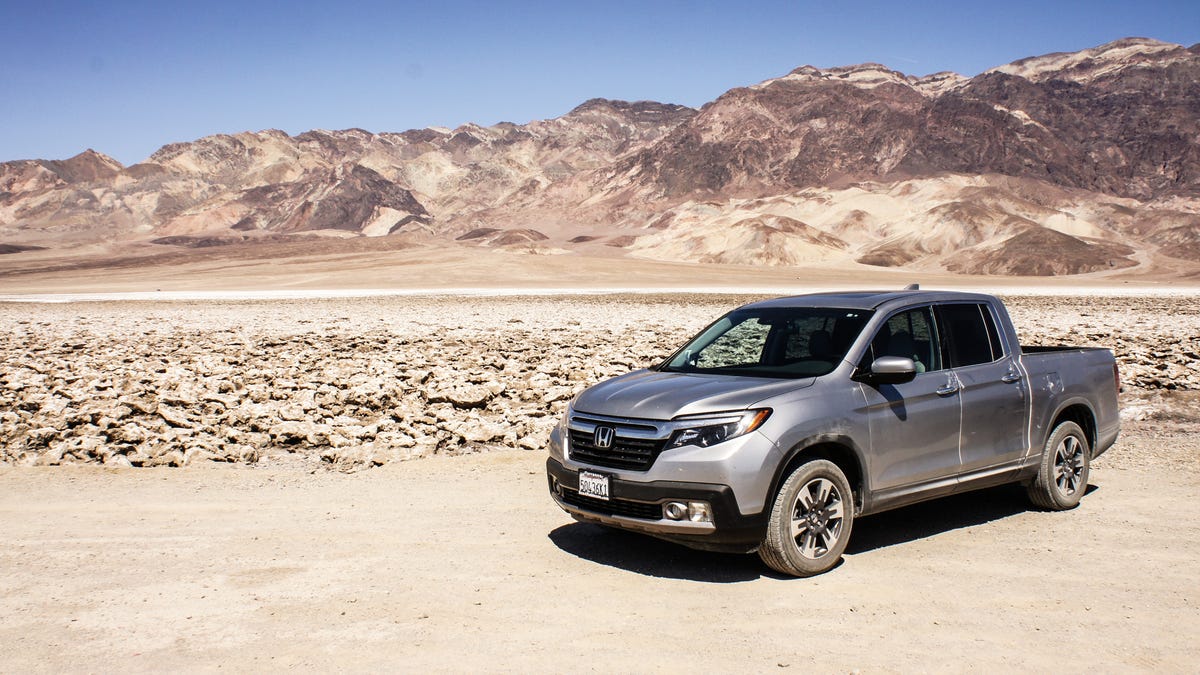2017 Honda Ridgeline long-term update: Oops, we blew out the shocks
Looks like the suspension couldn't handle 52 miles of bone-jarring washboard dirt road. Thank goodness for that factory warranty.

We've had our long-term Honda Ridgeline since December here in San Francisco, and it's been a great addition to our fleet. The producers love all the cargo space for camera gear, I've used it to tow my race car, and Antuan took it out to the darkest spot in Nevada to check out the stars.
But it's not all fun and games. We recently found out that the Ridgeline's rear shocks did not survive a trip to Death Valley. After 52 miles of washboard road they had to be replaced. Fortunately they were under warranty and a quick trip to the dealership fixed us back up.
People hang tea kettles at the sign marking Teakettle Junction, 20 miles down the washboard road leading to the Racetrack in Death Valley, California.
When I heard my off-road race car was finally ready for testing, I hopped in the Ridgeline to make the six-hour buzz down to the high desert from Roadshow HQ in San Francisco. As much as I love driving my Mazdaspeed Miata, it is, quite frankly, a pain in the ass on long stretches of straight highway. I'm glad to have the option of the more comfortable Ridgeline with its adaptive cruise control and Apple CarPlay.
My trip was relatively stress-free until I dropped into the Mojave Desert itself. You would think traffic would be easy-peasy in the unpopulated California desert, but you'd be wrong. One particular stoplight is notorious for backing up traffic for miles on a two-lane stretch of highway 58. Add temperatures over 100 degrees and I was turning into a Ms. Crankypants pretty quickly.
The Ridgeline can handle dirt tracks easily, as long as they don't get too washboard-y.
But hey, this is the high desert. We don't need no stinking pavement. As soon as brake lights started flashing I cranked the wheel to the right and blasted off on the dirt path, parallel to the road. See ya, suckers!
The new shocks in the rear behaved beautifully, and while the dirt tracks here next to the road are far from difficult, they can be quite soft. Here is where the Intelligent Traction Management system comes in. A press of a button brings up options for Mud or Sand, each with calibrated throttle, shift points and all-wheel drive parameters to produce the most traction.
I selected Sand, which essentially throws almost all the power to the rear wheels, lets the engine rev higher before shifting and provides a more aggressive throttle. Traction control isn't turned off completely but does allow for more wheel spin.
Push button for magic.
Sand mode and a bit of momentum carried me through the worst of it without a problem. Ten minutes later I had bypassed the traffic and was back on the pavement, leaving the other poor souls to sweat it out on the highway.
The Ridgeline does surprisingly well in the dirt, for those adventurous enough to take it there. It won first place in the crossover class of the 2016 Rebelle Rally, where navigational accuracy, not speed is the name of the game. It traversed dirt roads and open desert from Lake Tahoe, California all the way south to the dunes of Glamis, California near the Mexican border. Yeah, it looks like a truck but technically it's an all-wheel drive crossover with its unibody construction, independent suspension all the way around and lack of a two-speed transfer case.
Despite my first misgivings about the Ridgeline, I've come to understand that even if it's not a "real" truck, it can still function like a real truck 95 percent of the time. It's not going to haul a dozen horses or climb up the steepest rocks in Moab, but that's not why most folks need a truck. The Ridgeline stays comfortably in the mainstream, leaving the extreme performance to the Toyota TRD Tacomas and Ford Raptors of the world.
The 2017 Honda Ridgeline on its way to first place in the 2016 Rebelle Rally.
But if sales numbers are to be believed, people buy what they want, not what they need. From June 2016 to June 2017, the Ridgeline sold only 42,261 units, compared to 116,848 units of the Chevrolet Colorado and 207,001 units of the Toyota Tacoma in the same period.
For me personally, I would want a bit more off-road performance as any truck I buy would double as a chase truck for off-road desert races. For now, however, we have a Colorado for chase purposes so the Ridgeline suits my needs just fine. It can tow my race car with ease, and it's a welcome respite from the stiff chassis of my daily driver on long drives.
The Ridgeline has a towing capacity of 5,000 pounds, more than enough for my needs.

